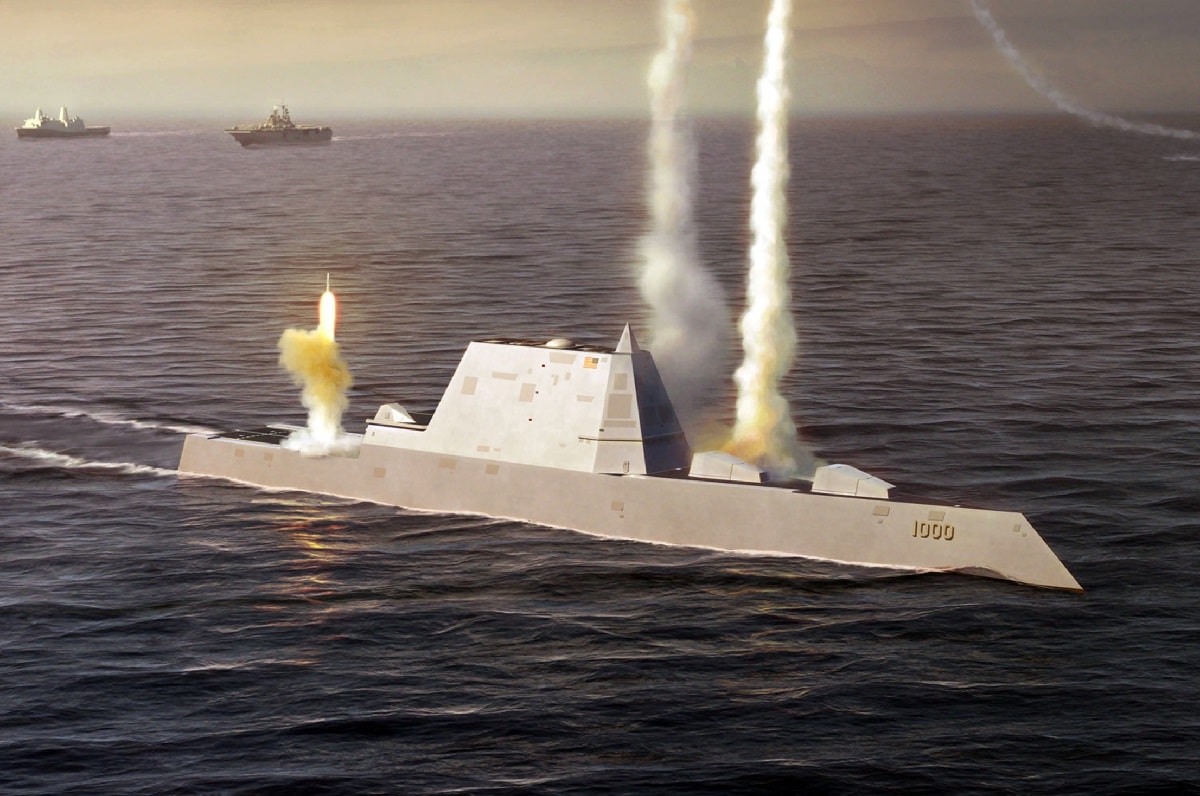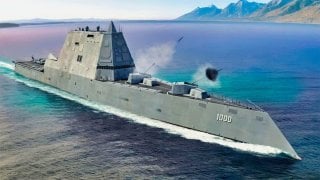Zumwalt-Class Stealth Destroyer: Hypersonic Missile Truck or Giant Failure?
Zumwalt will be pushing ten years old once its hypersonic weapons are installed, assuming its current yard period wraps up on schedule. That’s a sizable share of its service life.
Zumwalt-Class: Will it be a success or failure in the long run? It is neither fast nor cheap nor easy to swap out a warship’s major armament for something completely different. Nor is success foreordained.
Exhibit A: the U.S. Navy’s Zumwalt-class stealth destroyers. The buzz surrounding these three otherworldly-looking men-of-war has been muted of late. That’s because, for good reasons and bad, DDG-1000s remain a warship class of the future seven and one-half years after the lead ship formally entered service. Late last summer USS Zumwalt put into Pascagoula, Mississippi, to have its gun mounts removed and replaced with vertical launch cells—in effect silos embedded in the ship’s main deck and the innards below—for firing intermediate-range hypersonic missiles under the “Conventional Prompt Strike” program.
Conventional Prompt Strike is a U.S. Navy venture undertaken in conjunction with the Army’s “Long Range Hypersonic Weapon” program. If it bears fruit the collaboration will produce a “common hypersonic glide body,” a hypersonic guided missile deployable with both the sea and ground services. Hypersonics fly at Mach 5 or above and can maneuver to avoid an enemy’s defensive fire. Their characteristics boost the probability of a kill. Zumwalt’s vertical launch system will house a dozen of these lightning-quick missiles within four bulky large-diameter (87 inches wide) tubes. Pascagoula shipyard Huntington Ingalls Industries is slated to finish the backfit by 2025.
But can it? The schedule’s the rub.
Industry and the Pentagon are trying to expedite refitting the ships for a new primary mission while still developing and testing their main armament. That they can pull all of that off on time is far from foreordained considering the novelty of hypersonic weaponry, and considering defense firms’ well-documented track record delivering ships of war late and over budget. Last summer, for instance, the Government Accountability Office (GAO) published its latest “Weapon Systems Annual Assessment.” Among many other findings, the report voiced doubts about the maturity of several technologies on board Zumwalt as well as the missiles themselves.
Trouble is, technology has a way of refusing to develop on command or on the clock. Here’s the verdict from GAO investigators: “if the hypersonic weapon is not ready for integration on the DDG 1000” during its now-ongoing sojourn in Pascagoula, “the Navy may have to extend the duration of the planned maintenance period or wait for the next scheduled period to incorporate the system on the ship.”
In other words, navy magnates may have to choose between two unpalatable alternatives. One, they could opt to get a subpar but functional Zumwalt out of the yard on time and into a fleet that could sorely use additional hulls. If so they would presumably—as the GAO team speculated—designate the next ship in the class, USS Michael Monsoor, as the missile test platform and delay arming Zumwalt with hypersonics until its next yard period. Or two, they could leave Zumwalt languishing in the yard for an indefinite time awaiting its main armament.
One imagines they would prefer option one—availing themselves of a ready-to-deploy warship that lags its potential—to leaving the vessel idle and hoping its missiles are declared battleworthy before too long. That logic is sound. Never let the best be the enemy of the good—or the adequate.
Now, Zumwalt will be pushing ten years old once its hypersonic weapons are installed, assuming its current yard period wraps up on schedule. That’s a sizable share of its service life. No surprise there. Conversion to a hypersonic main battery was bound to be a traumatic process. The DDG-1000 was built as a gunship that could loft precision-guided projectiles up to sixty miles, bombarding shore targets in support of ground forces. Its focus was dry earth. But when the news broke that the cost of its high-tech shells had spiked to $800,000 per round or more—a blatantly unaffordable sum—the navy leadership opted to repurpose the class for surface warfare. Surface warfare means dueling rival surface fleets for marine supremacy.
Zumwalt’s focus is now the wine-dark sea.
And frankly, that was a welcome update for the times. Fighting for command of the sea is the first and foremost task for any navy. That belief was graven on the U.S. Navy’s DNA until the Cold War ended and the service talked itself into believing that victory had rendered battles for sea control moot for all time. History had ended. That’s when carrier battle groups became carrier strike groups, for example. A battle group prepares to fight formidable peer foes like the Soviet Navy. A strike group assumes it will face no meaningful high-seas opposition and can venture close inshore to pummel whatever targets commanders ordain along hostile coastlines.
Reinventing the Zumwalt class, then, marks a turn back to an older, more gimlet-eyed, healthier attitude toward naval warfare. Namely, the sea is never an offshore safe haven for long. Sooner or later a new challenger will come along, and with it the specter of nautical strife.
What should the U.S. Navy high command do with the DDG-1000s if and when they do emerge from the yards toting workable hypersonic missiles? Well, all three destroyers should make their home in the Pacific. The biggest drawback to the Zumwalt class is mass—numbers of hulls. The closest precedent for such a small class is the four Iowa-class battleships recommissioned during the 1980s. That was a lean flotilla in terms of brute numbers, but with four battlewagons the navy had enough to station two on each coast, reasonably confident of having one ready for action in each ocean at any time. And so that’s what the leadership did.

There’s no such economy of scale with the DDG-1000. It would make little sense to station two Zumwalts on the west coast, presumably at San Diego, and the other on the east, presumably at Norfolk. Best to keep all three hulls in the Pacific, the priority theater, rather than sacrifice robust coverage in the Pacific for intermittent coverage in the Atlantic, the theater commanding lesser importance. Concentrating finite resources where they’re needed most is basic strategy.
Hello, Indo-Pacific Command.
The DDG-1000 class could perform yeoman duty in a scrap with China. For example, if U.S. joint forces opted to seal off the first island chain to Chinese shipping and aircraft, stealthy destroyers brandishing hypersonic missiles would make excellent mobile forces for patrolling behind the Great Wall in reverse. They could evade hostile detection, tracking, and targeting more easily than can nonstealthy surface combatants. Elusiveness would grant them staying power. Meanwhile long-range armaments would help them target Chinese ships that essayed a breakout into the Western Pacific. And if the wall held, they could shift their fire to pummel China’s navy within the China seas.
Zumwalts, in short, would make a welcome part of a layered defense against aggression.
Weirdly, though, the most daunting hurdle to using these ultramodern warships in action could be psychological. The Zumwalt class was inordinately expensive, coming in at $22.5 billion in FY 2015 dollars according to GAO. That’s a whopping $9.7 billion in FY 2023 dollars for each copy of a 16,000-ton ship, compared to $14.2 billion for USS Gerald R. Ford, a nuclear-powered aircraft carrier displacing over six times as much.

The point is that, in the case of both Zumwalt and Ford, it would be hard for any commander to hazard such a massive investment of taxpayer dollars in combat. That’s a lot to risk, and so commanders might turn risk-averse when they need to be venturesome. The price tag, compounded by the tiny number of hulls in the DDG-1000 inventory—lose one and you lose a third of the fleet—could induce destroyer captains or their superiors to flinch at using the Zumwalts aggressively. Even when the battle situation warrants it. Only the most enterprising officers should be put in charge of these behemoths.

So there’s your roundup of DDG-1000 news. The bottom line is that repurposing a warship for new times is an endeavor fraught with uncertainty. Let’s hope the Zumwalt class is worth the wait. We need these ships of the future—pronto.
About the Author: Dr. James Holmes, U.S. Naval War College
Dr. James Holmes is J. C. Wylie Chair of Maritime Strategy at the Naval War College and a Distinguished Fellow at the Brute Krulak Center for Innovation & Future Warfare, Marine Corps University. The views voiced here are his alone.


